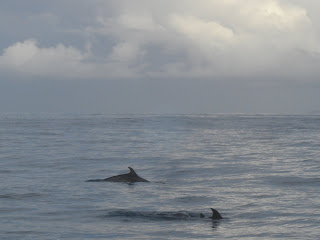 15/06/09 - 17/06/09
15/06/09 - 17/06/09From Manuel Antonio, we headed south to the Osa Peninsula with Martine and Baudewyn, the couple from Amsterdam that we had been sharing a room with (they are the ones wearing the life jackets in the photo below). It was a long journey so an early start was called for. Our first bus took us back to Dominical of all places, which had been the beach we had visited a few days earlier. We certainly didn´t think we would ever have another reason to go back there, but there we were, and it actually didn´t seem too bad the second time around :) From there we took another bus to Parmar Norte, a taxi to Sierpe, and finally a boat to Drake Bay (which gets its name from Sir Francis Drake who docked there in 1579). Before reaching the sea, the boat took us along the River Sierpe, which had lots of greenery floating about in it, which, we learned, is called lirio (that´s the Spanish word...I'm not sure of the English translation). The plant was brought over from Columbia to protect the wildlife from the chemicals used to fumigate the banana plantations alongside the river. The United Fruit Company used to have several plantations in the area until the labour unions started demanding a payrise for the workers (or so we´ve been told). The banana trees have since been replaced with African palms, which produce African palm oil, and because the African palms do not require the same chemical treatment, the amount of lirio in the water just keeps on growing. When we reached Drake Bay, after a rather bumpy crossing, we noticed that there was no dock - everyone had to jump off the boat into the water, while a few men kept the boat steady - not the easiest thing to do with the tide going in and out, but fun nevertheless :)
 Drake Bay is a very small and sleepy town, and we loved the few days we spent there. The highlight of the trip was the day spent at the Corcovado National Park, which was an hour and a half´s boat ride away. We were a group of seven, plus our guide, who was brilliant and knew all the right places to look in to find the animals. On the way to the park we stopped a few times to see dolphins and flying fish (they really do appear to fly), and later on in the park while out on the coast, we even saw sharks. They were bull sharks, which are one of the three types of shark known to attack humans, so thank goodness they were quite far away :) We also saw all four types of monkey that inhabit Costa Rica (there is a picture of a howler monkey below - they make the most awful sound), two tapirs, the biggest mammal in Costa Rica (we were able to get up close to one of them as our guide knew a place where they usually sleep - Vic has a great photo below), anteaters, crocodiles, peccaries and lots of birds, my favourite being the macaw because it´s so colourful. We even saw a few of them on the beach the next day (see photo above). We were lucky to stay at another great hostel (Cabinas Manolo), with very friendly owners. They even treated us to a few lychees from their tree - I had never eaten lychees before and never even seen them with their skin still on, so I didn´t have a clue what they were when they gave them to us, but I´ve developed quite a liking for them now :)
Drake Bay is a very small and sleepy town, and we loved the few days we spent there. The highlight of the trip was the day spent at the Corcovado National Park, which was an hour and a half´s boat ride away. We were a group of seven, plus our guide, who was brilliant and knew all the right places to look in to find the animals. On the way to the park we stopped a few times to see dolphins and flying fish (they really do appear to fly), and later on in the park while out on the coast, we even saw sharks. They were bull sharks, which are one of the three types of shark known to attack humans, so thank goodness they were quite far away :) We also saw all four types of monkey that inhabit Costa Rica (there is a picture of a howler monkey below - they make the most awful sound), two tapirs, the biggest mammal in Costa Rica (we were able to get up close to one of them as our guide knew a place where they usually sleep - Vic has a great photo below), anteaters, crocodiles, peccaries and lots of birds, my favourite being the macaw because it´s so colourful. We even saw a few of them on the beach the next day (see photo above). We were lucky to stay at another great hostel (Cabinas Manolo), with very friendly owners. They even treated us to a few lychees from their tree - I had never eaten lychees before and never even seen them with their skin still on, so I didn´t have a clue what they were when they gave them to us, but I´ve developed quite a liking for them now :)




¡Qué bueno! Supongo que si yo veo una serpiente salgo nadando hasta Japón con el perezoso a mis espaldas... Espero que sigáis disfrutando a tope y que tengáis cuidado si vais a Honduras, que la cosa está más difícil que envolver un triciclo...Un abrazo para los dos
ReplyDeleteme alegro saber, la selva me gusta, debe oler diferente, limpio,sano,sin contaminacion, todo parece inexplorado, aunque ya estas tu para descubrir algo nuevo, seguir asi,muchos besos mama madrid.
ReplyDelete